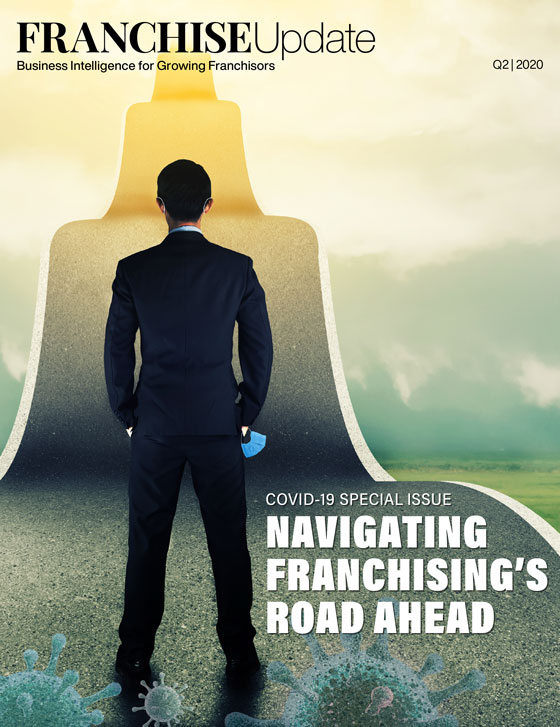How (and Why) To Establish a Post–Covid-19 Proactive Resale Program

As the coronavirus pandemic reshapes consumer buying habits and franchisors pivot their strategies to remain relevant, it’s critical to optimize resale programs given a potential acceleration in transfers. Here are the best practices for establishing a proactive resale program that can help lead a franchise system through the economic crisis and beyond.
In the best of times, franchisees sell for a variety of reasons: retirement, diversification, or to exit underperforming locations. Brands sell company units to raise cash to fuel innovation or to support franchise growth. Given the extreme market changes under way, a formal resale program actively assists buyers and sellers in completing transfers aligned with post-pandemic growth plans.
If franchisors react to transfers by relegating tasks to legal, administrative, or operations staff, they risk losing a significant opportunity to accelerate strategic brand pivots to survive the crisis. Proactive resale programs effectively realign market growth plans, deal with persistent unit underperformance, encourage franchisee collaboration through mentorship, and even motivate consolidation or partnerships between franchise groups. Potentially, such resale programs can yield a future franchisee base capable of maintaining and growing their businesses, adopting innovative brand strategies, and collaboratively testing and exploring new ways to compete as the brand rebalances the on-site versus at-home customer experience.
How to start
Where does a chain start to develop a proactive resale program? First, build the program on a foundation of data analysis composed of key market and franchisee performance data. The data will show which franchisees can grow and who should consider exiting the system –identifying potential buyers and sellers. Analysis starts by ranking unit-level financial and operational performance data by franchisee and market. Typical data includes franchisee EBITDA, post-debt cash flow, sales trends, adherence to brand standards, reinvestment in the business, and customer feedback. The rankings will show which units and franchisees outperform and underperform the median.
Develop a team
Next, establish a market planning team composed of franchise experts in financial analysis, real estate, operations, and marketing to review the results and assess growth opportunities and challenges segmented by franchisee and market. Develop an improvement plan for underperforming units in collaboration with franchisees. Monthly milestones help track initiatives and results. While franchisees implement improvement plans, the brand’s franchise business development experts (managing franchise recruitment, transfers, and acquisitions) engage underperforming franchisees to consider ways to reduce high rent or debt costs. The team can explore if short-term royalty reductions linked to improvement plan achievements might assist or motivate these franchisees to reach their goals.
Early plan results will show which franchisees can: 1) grow, 2) maintain what they have, and 3) consider exiting the system. A formal resale program engages franchisees to see what path they will take. In the event a franchisee decides to leave the system, offering a formal resale program connects buyers and sellers to complete transactions and stabilize the chain.
Setting the price and making the deal
It can be challenging for franchisee sellers to determine a purchase asking price. They must navigate the complicated business valuation process (considering business assets, operating cash flow, current market demand) and reconcile a buyer’s future debt limits based on the unit’s current cash flow and fixed costs, slowing the transfer process. Franchisors can take an active role in educating sellers on minimum franchise approval standards, debt limits, refer potential buyers, and even streamline the process further by negotiating a deal using a purchase option agreement. The agreement establishes a purchase price and determines whether the buyer or seller will pay for business obligations, such as remodeling or facility investments. The franchisor can assign the negotiated purchase option agreement to approved buyers within 180 days, typically alleviating the burden on the seller. Franchisees focus on maintaining and improving their locations while the franchisor sources approved buyers and assigns an already negotiated deal.
With a signed purchase agreement, buyers and sellers must complete the franchisor’s transfer process. A “Buyer’s and Seller’s Guide” is the easiest way to communicate the next steps, including buyer application and approval, FDD delivery, training, financing, facility inspections, and closing. Franchise approval standards clearly outline a buyer’s minimum qualifications and provide guidelines on transaction approval details such as debt limits. Also, list third-party service providers as additional resources, such as business brokers, merger/acquisition advisory companies, business valuation firms, and lenders. Make sure resource listings include at least three providers in each category. The providers will need to acknowledge approval standards and agree to follow the transfer process.
Finally, before implementing a new program, explore the benefits of using a customer relationship management (CRM) system such as Salesforce or FranConnect. CRMs help manage the administrative functions, track cross-functional communication, deadlines, and legal compliance throughout the resale process.
Summary
In summary, a proactive resale program enhances the transfer process and drives franchisee engagement. The franchisor helps their system adapt and stay competitive during the crisis by taking the lead to analyze franchisee performance data and assist franchisees with resources for improvement. In the event franchisees seek an exit, franchisors can help market the resale of their business by using a purchase option agreement. Growth-oriented franchisees can acquire units and simultaneously take part in strategic brand pivots.
Perhaps in the future, we’ll recognize the pandemic as the catalyst that tipped the balance resulting in a revised retail landscape – one with more drive-thrus, more walk-ups, and more at-home deliveries. Flagship retail locations may remain as the unique, curated, and coveted brand experience sought after by the most loyal customers. When a formal resale program manages the transfer process proactively, it will align all stakeholders to enable this adaptation to happen.
Grant Kreutzer serves as a strategic franchise business development advisor with nearly 20 years of experience launching brands’ franchising and resale programs, including refranchising company units. Contact him at grantkreutzer@gmail.com.
Share this Feature
Recommended Reading:
Comments:
comments powered by DisqusFRANCHISE TOPICS
- Multi-Unit Franchising
- Get Started in Franchising
- Growth
- Operations
- Open New Units
- Leadership
- Marketing
- Technology
- Legal
- Awards
- Rankings
- Trends
- Featured Franchise Stories
FEATURED IN

Franchise Update Magazine: Issue 2, 2020






 The franchise listed above are not related to or endorsed by Franchise Update or Franchise Update Media Group. We are not engaged in, supporting, or endorsing any specific franchise, business opportunity, company or individual. No statement in this site is to be construed as a recommendation. We encourage prospective franchise buyers to perform extensive due diligence when considering a franchise opportunity.
The franchise listed above are not related to or endorsed by Franchise Update or Franchise Update Media Group. We are not engaged in, supporting, or endorsing any specific franchise, business opportunity, company or individual. No statement in this site is to be construed as a recommendation. We encourage prospective franchise buyers to perform extensive due diligence when considering a franchise opportunity.